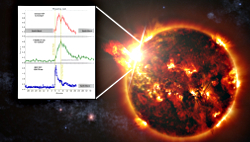HEAPOW: A Blast for Proxima Centaurions (2017 Jul 31)
Posted: Mon Jul 31, 2017 3:31 pm
 HEAPOW: A Blast for Proxima Centaurions (2017 Jul 31)
HEAPOW: A Blast for Proxima Centaurions (2017 Jul 31)
Recent studies suggest that many (if not most) of the stars in the Milky Way are orbited by planets. Some fraction of these planets may host living things. Liquid water is believed to be essential for the chemical processes needed for life to arise on a planet. But liquid water only exists in a narrow temperature range: too cold and water freezes, too hot and it boils away. Since the temperature of a planet is determined in large part by its distance from its host star, there's a particular range of distances (the "habitable zone") within which a planet needs to orbit in order for life to have a chance to arise. But there are lots of roadblocks on the path to life, even for planets within the habitable zone. Stars are not simply constant, gentle sources of radiation. Most stars have unstable magnetic fields, and these magnetic fields can produce enormous eruptions, with energies millions of times more powerful than the most powerful hydrogen bomb. The nearest planetary system outside our solar system orbits Proxima Centauri, and one planet, called Proxima Centauri b, is a rocky body like earth that lies in the habitable zone of Proxima Centauri. But, because Proxima Centauri is a particularly unstable type of low-mass star, its habitable zone environment is harsh. To understand how harsh, astronomers organized a campaign of observations using the Hubble Space Telescope, the Chandra X-ray Observatory, and Astrosat (India's first X-ray space observatory), to study the amount of dangerous radiation produced during one of Proxima Centauri's stellar flares. The image above is an artist's illustration of Proxima Centauri and its active regions (based on an interpretation of a superflare observed on a star called DG CVn). The inset shows the dangerous radiation from the ultraviolet to the X-ray regime emitted by one of Proxima Centauri's powerful stellar flares.
Astrosat, Chandra, and Hubble Space Telescope simultaneously
detect a coronal explosion on the nearest planet-hosting star
| << Previous HEAPOW | High Energy Astrophysics Picture of the Week | Next HEAPOW >> |